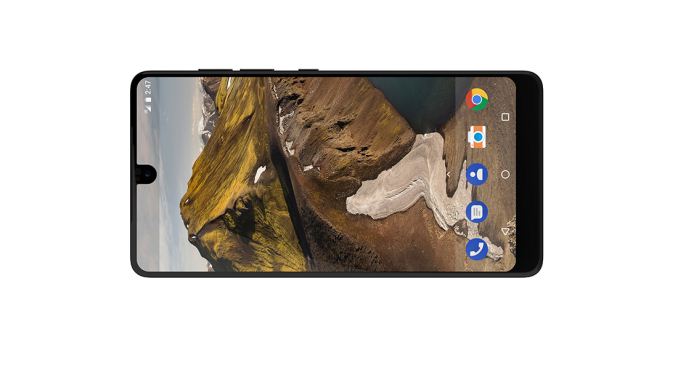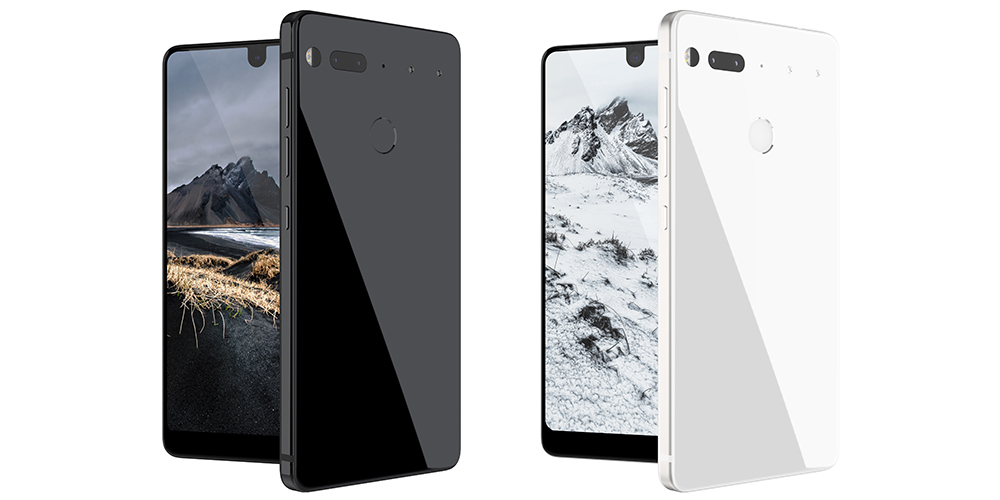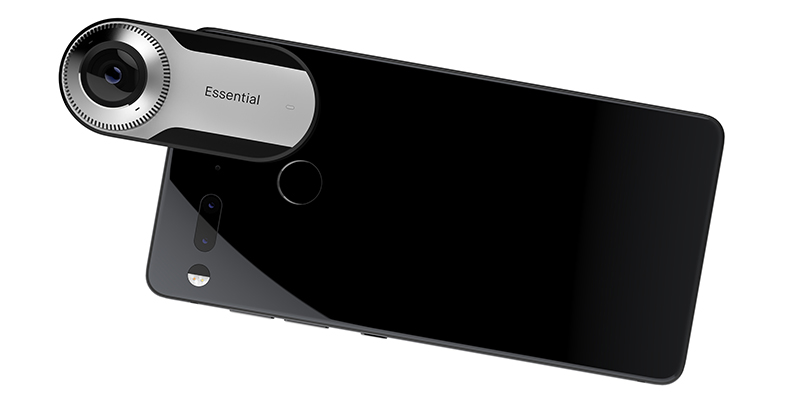Android Co-Founder Introduces Essential Phone: S835, Slim Bezels, Dual Camera
by Matt Humrick on June 1, 2017 1:50 PM EST- Posted in
- Smartphones
- Mobile
- Snapdragon 835
- Essential

Andy Rubin, co-founder of Android and now CEO of Essential Products, recently unveiled his company’s first products: the Essential smartphone, a 360° camera accessory, and the Essential Home—a smart home assistant to compete with Amazon’s Echo and Google’s Home.
The hardware inside the Essential PH-1 is what you would expect for a premium phone: Snapdragon 835 SoC, 4GB of RAM, and 128GB of UFS 2.1 storage. It comes with the latest connectivity options too, including 802.11ac Wi-Fi, Bluetooth 5.0 LE, NFC, and a Snapdragon X16 LTE modem that makes the phone compatible with all US networks. However, a few items some people find essential are missing; there’s no microSD card support for storage expansion, no support for dual SIMs, and no 3.5mm headphone jack (it will come with an adapter). The 3040 mAh battery, essentially the same capacity as the Galaxy S8’s 3000 mAh pack, should be adequate for most people, but power users will likely find themselves using the Essential’s 27W quick charge feature.
| Essential PH-1 | |
| SoC | Qualcomm Snapdragon 835 4x Kryo 280 Performance @ 2.45GHz 4x Kryo 280 Efficiency @ 1.90GHz Adreno 540 @ 710MHz |
| Display | 5.71-inch 2560x1312 (19:10) IPS LCD |
| Dimensions | 141.5 x 71.1 x 7.8 mm 185 grams |
| RAM | 4GB |
| NAND | 128GB (UFS 2.1) |
| Battery | 3040 mAh non-replaceable |
| Front Camera | 8MP, f/2.2 |
| Rear Camera | Color: 13MP, f/1.85, PDAF + Laser AF + Contrast AF, HDR, dual-tone LED flash Monochrome: 13MP, f/1.85 |
| Modem | Snapdragon X16 LTE (Integrated) 2G / 3G / 4G LTE (Category 16/13) FDD-LTE / TD-LTE / TD-SCDMA / WCDMA / CDMA / GSM |
| SIM Size | NanoSIM |
| Wireless | 802.11a/b/g/n/ac MIMO, BT 5.0 LE, NFC, GPS/GLONASS |
| Connectivity | USB Type-C, Essential Accessory Connector |
| Launch OS | Android 7 |
| Launch Price | $699 US |
Its camera arrangement also sounds suitable for a high-end device. The dual-camera module around back contains a 13MP color sensor and a 13MP monochrome sensor, which captures about twice the amount of light as the color sensor without an RGB Bayer filter to block incoming photons. In addition to capturing better black-and-white images, the Essential also combines the luminance data from the black-and-white sensor with the color data from the other sensor, which should produce brighter color images with less noise and better contrast. This actually sounds very similar to the camera setup in Huawei’s P9 and Honor 8. The Essential lacks OIS like the newer Huawei P10, but its wide-aperture lens (f/1.85) should let in more light, so this may not be a disadvantage.
It’s not what’s on the inside that distinguishes the Essential phone from other flagships, though. Premium design and materials are its hallmarks. The frame is made from titanium, which is stiffer and stronger (and heavier) than aluminum. Essential Products says this makes its phone more resilient to bending, scratching, or denting when dropped or mishandled. A piece of polished ceramic forms the back, giving the phone a sleek, glossy look that’s completely free of any logos or markings, although the quick accumulation of fingerprints will lower its lustre. There’s a fingerprint sensor right where you would expect, and lined up in a neat row along the top is the dual-tone LED flash and laser unit—part of the rear camera’s PDAF, laser AF, and contrast AF hybrid autofocus system—the flush-mounted dual rear camera, one of 4 total microphones, and two power pins.
Those power pins are part of the Essential’s Wireless Accessory Connector that allows optional accessories, such as its 360° camera, to magnetically attach to the phone. The pins transfer power while data is transferred wirelessly via a 60GHz, 6 Gbps connection. Modular phones are not new—LG tried and failed with the G5 and Google’s concept never made it to production. Motorola’s Moto Mod system, which also uses magnets for attaching accessories to the back of its Moto Z phones, is the best implementation to date, but, like the other attempts, requires some compromises to the phone’s design. I’m not sure Essential’s solution will be as flexible as Motorola’s in terms of the types of accessories that it will accommodate, but it’s the first system that does not appear to negatively impact the phone’s thickness, weight, or battery size.
Around front there’s a nearly edge-to-edge display covered by Gorilla Glass 5. Like LG’s G6 and Samsung’s Galaxy S8, the Essential’s display is stretched vertically, resulting in a larger screen that keeps the frame narrow enough to comfortably hold with one hand. We’ve seen several OEMs move away from traditional 16:9 displays recently, but there’s still no consensus on what the optimal aspect ratio should be. The G6 (18:9), S8 (18.5:9), Xiaomi Mi MIX (17:9), and now Essential (19:10) are all slightly different, with the G6 and S8 opting for narrower screens. The Essential’s unique 5.71-inch IPS display has a 2560x1312 resolution and rounded corners. Unlike the Mi MIX that uses IGZO (indium gallium zinc oxide) thin-film transistors (TFTs) in its backplane to improve efficiency, the Essential uses LTPS (low-temperature polysilicon) transistors that are commonly found in flagship IPS displays.
The Essential uses onscreen navigation controls, leaving only a slim bezel below the screen and very little surrounding the edges and top. The top of the display is scalloped, making space for the front-facing 8MP camera and the ambient light and proximity sensors. This means the camera lives in the middle of the status bar along the top of the screen, which is either a clever use of wasted space if you prefer an uncluttered status bar, or a potential annoyance if you prefer to pack this area with information. A very thin and wide earpiece sits above the camera right along the top edge. I’m not sure how it will perform, but it’s incorporated in a way that makes it almost invisible, which is pretty neat.
The Essential phone is currently available for pre-order directly from Essential Products for $699 (US only). For a limited time, you can get the 360° camera accessory for an additional $50. Color options include Black Moon (black frame) and Pure White (silver frame), with Stellar Grey (grey frame) and Ocean Depths (green with gold frame) coming soon.













42 Comments
View All Comments
sonny73n - Friday, June 2, 2017 - link
He created an Android phone while still obsessed with the iPhone. Hence no SD card slot and headphone jack. Between this expensive ugly crap and the $70 iPhone 4, I'll take the latter.gg555 - Friday, June 9, 2017 - link
"No audio jack and no microSD, this guy has never used Android. It's hard to start with a bigger disaster than that. It shows ignorance..."Uh, you understand that Andy Rubin is the ceator/inventor of Android, right? He invented Android, then it was bought by Google, then he was the head of development of Android for Google for eight years until it became the global dominant phone OS. Oh yeah, and "Android" was Rubin's nickname, because he loved robots, when he was younger. So the Android operating system is in fact named after Rubin. So I suspect he has used Android, just a little.
Whatever you think of the phone design, saying that the person who made this phone does not understand Android is the only ignorance going on here.
peevee - Thursday, June 1, 2017 - link
No firm promise of timely Android updates for 3+ years = no buy.And why the hell the non-replaceable battery again?
Somebody, please make an honest phone with US frequencies including Band 12 (and Qualcomm modem, I don't care if CPUs are Qualcomm or not).
0. Pure Android with immediate updates, including availability of betas, right after they are submitted to AOSP!!!
1. Fast CPU
2. Big, replaceable battery
3. No useless waste of battery for screen with too high resolution and power-hungry GPU to feed it, 1280x800 would do.
4. No bezels.
5. At least 1/2.3" rear sensor, OSPDAF, 4k, f/2 or faster. Sony's 23mpix would be good for digital zoom/cropping (if lens is fast and sharp in the middle), no 2nd camera needed.
6. Fast flash and DRAM.
7. IP68.
8. Honest price, if Qualcomm wants too much for S835, use Huawei or Samsung or whatever with at least a couple of fast cores. NO, 64GB of extra flash DOES NOT cost $100, look at SSDs, full 64GB SSD is $37 retail already, 128GB is $52 so it is $15 extra, retail.
MicroSD/2nd SIM slot would be good but not essential.
gg555 - Friday, June 9, 2017 - link
What flagship smartphone in the last several years has had a user replaceable battery? How can people still be complaining about this when it's been long gone for years now.Anyway, your phone design suggestions would result in a phone that would be the size of a small tablet a weigh twice as much as most phones. If people want large screens (regardless of resolution) in a reasonable sized device, then something has to be scarificed.
People want all these things and don't understand that there are just basic design limitations and then complain when magic can't happen.
Also, your phone wouln't be any cheaper. The markup on flagship Android phones is only about 10% (30% on the iPhone). This phone is priced right in line with other flagship phones.
No one is going to sell you a device at no profit.
And if you really don't care about the chipset that much and want only a couple fast cores, well that exists in the Snapdragon 6xx series chipsets. Just get a mid tier phone, like the Moto G, it will be cheaper and have most of what you want. But don't expect anyone to throw in all kinds of flagship features and then use a mid tier processor.
cfenton - Thursday, June 1, 2017 - link
Good luck to them, I guess. $700 seems way too high for a product from an unknown and unproven company. I think that's too much for a phone from Apple, Google, and Samsung, but at least I know they'll be in business next year if I need support.RaistlinZ - Thursday, June 1, 2017 - link
Ditto. At $499 this thing might have a future, as long as they guarantee Android updates through the end of 2019. But at $699 I think not.Arbie - Thursday, June 1, 2017 - link
Reminds me of the Amazon Fire phone. Not a bad deal at less than $200... after a few months. Though still no microSD card, so it's not for the benighted non-cloud me.Aloonatic - Friday, June 2, 2017 - link
This might be something off an off comment but....Am I the only one that always puts there phone in case (where possible) that is as thin as possible but it has a flap that covered the screen which wakes it up when you open it?
So far only the Moto G seemed to have a manufacturer made option that was like this, so why don't more phone makers put some effort into this?
It seems that most people you see have either a slim sexy phone in a big fat cases that hides away the designers hard work, or no case on it, so it looks great from a distance, until you get closer and see a section chipped out the side and the screen cracked in at least 1, if not 2 or 3 places.
If only more manufacturers would make a phone case that is actually useful and survivable in the real world that is good looking, slim (as it's designed into the phone casing from the get go) and perhaps even does not hinder the camera when the screen is visible, as the other annoyance is that the screen cover also covered the rear camera when it's opened up.
Maybe it is just me, but I feel a bit better for that mini rant :o)
phoenix_rizzen - Friday, June 2, 2017 - link
Motorola started the "always-on display" trend. LG, Samsung, and HTC copied it with later phones, and you could get cases directly from them that had cut-outs for showing info while closed.bigboxes - Friday, June 2, 2017 - link
I'm intrigued by the device. It's got the specs. Don't care about the lack of integrated headphone jack. Non-removable battery I'm used to and accept with form factor. I would like an SD card expansion slot, but not a deal killer. I'm not bothered by the front facing camera's location. To still include it and eliminate most of the bezel it is almost a requirement. It's 100% stock Android so you could update the OS whenever you want. I went to the website and they claim the titanium won't scratch, dent or bend. So, if it's durable enough to withstand most drops then it really comes down to price.